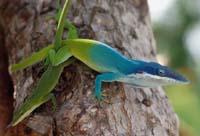Sexual dimorphism increases biodiversity

In many species it is frequent that the male and the female are morphologically different: color, size... This is what is known as sexual dimorphism. Some species of lizard are dimorphic. Therefore, they have worked with lizards to see if there is a relationship between sexual dimorphism and biodiversity. And there seems to be a relationship: sexual dimorphism makes biodiversity greater.
The research has been carried out with the Anolis lizards of the Great Antilles (Puerto Rico, Jamaica, Cuba and Hispaniola), which house eleven varieties of Anolis lizard, in which the lizards have grown separately, adapting to different media. According to the researchers, in this process, each sex of species with a large sexual dimorphism colonizes a certain ecological corner, which means an increase in biodiversity.
Buletina
Bidali zure helbide elektronikoa eta jaso asteroko buletina zure sarrera-ontzian











